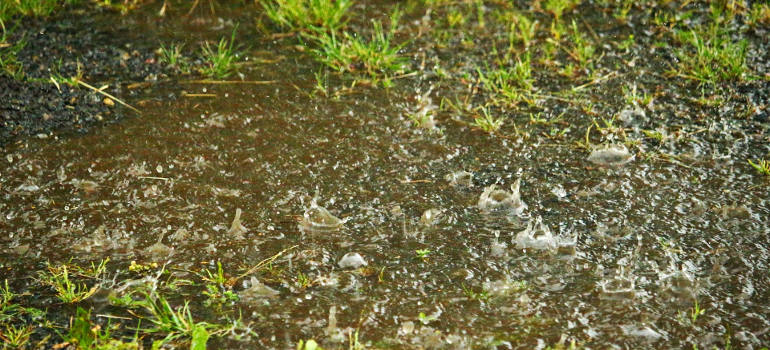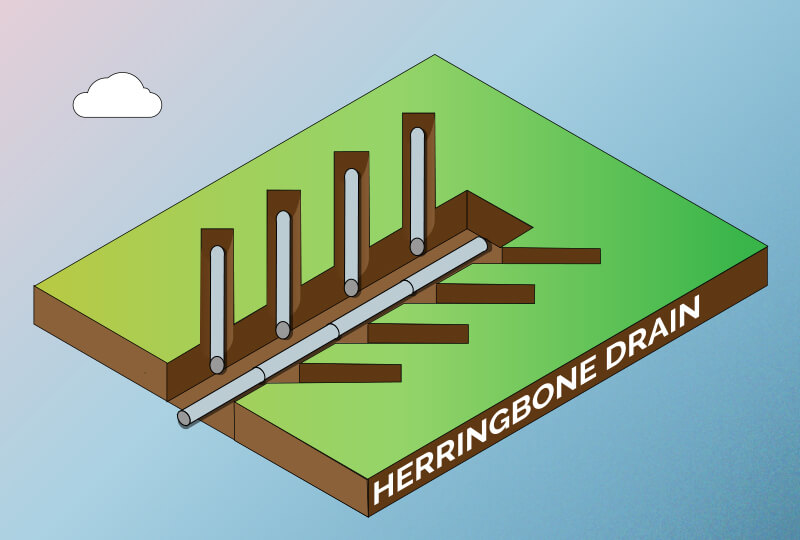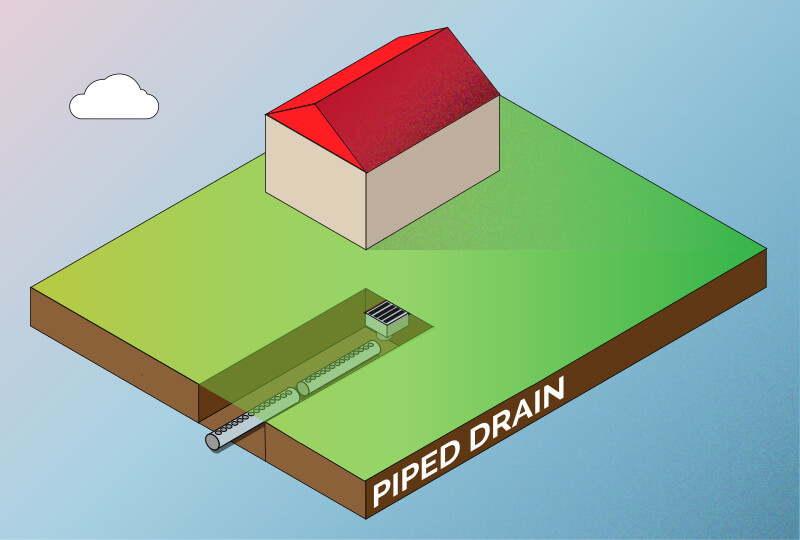
Water is the source of all life, but too much water can cause significant problems even in the garden space. For instance, surplus water can promote root rot and diseases amongst plants.
If your green space turns into a poodle-land every time it rains, this may indicate that your garden is in dire need of a drainage system. Below, you will learn what a waterlogged garden looks like and how to find out if yours is retaining too much water. You will also discover how to improve the drainage in your garden both organically and through feats of engineering.
Table of Contents
What is a waterlogged garden and what causes it?
Signs that you have a waterlogged garden
It’s very likely that you will recognise a soggy lawn or garden when you see one. Some of the symptoms include multiple puddles caused by rain that have trouble draining, squelching sounds upon stepping on the soil, reed or similar plants growing in the lawn, and the presence of moss.
10 factors that can lead to poor drainage
While there are myriad of reasons why your garden isn’t draining water properly, here are 10 factors that most likely contributed to your garden’s swamp-like appearance:
- Underground springs changed their direction as a result of heavy and continuous rainfall.
- Subsoil and topsoil were mixed together during property construction, creating compacted soil that water has a hard time draining through.
- Your property and garden have been built on top of a water-retentive clay layer (a pretty common situation in the UK).
- The garden is situated at the bottom of a hill or lower than those of your neighbours.
- You or your neighbours have built swimming pools, home extensions, or any other structure with a foundation deep enough to divert water.
- Your lawn or garden has an uneven surface that allows excess water to form puddles.
- Your garden or yard features a driveway, patio, or other impermeable surfaces.
- The guttering of your house is blocked or not connected to a drainage system.
- The level of the natural groundwater under the soil (the water table) is too high.
- Your neighbour’s garden drainage system diverts water to your property.
How to check if your garden has a H2O problem
Most drainage projects are not cheap. Before looking into any garden drainage ideas, we highly encourage you to confirm that your green space indeed has trouble draining water.
Here is how:
- Dig a hole into the soil that is approximately 60cm deep;
- Fill the hole with water and leave it be for about four hours;
- If the hole isn’t empty upon your return, then drainage is needed.
Note that, sometimes, especially after a heavy rain, accumulated surface water may also not drain as fast as usual. This, however, could mean that your soil simply needs to be aerated.
Types of garden drainage systems
Before doing any digging work whatsoever, always think about where the water needs to go first. This means that you need to locate a ditch, stream, or a soakaway (more on these later) that is located in close proximity to your garden in order to redirect surplus garden water there.
In some parts of England, connecting a drainage system to sewers or storm drains is forbidden, so always make sure to consult your local authorities first to avoid a fine. It should also be noted that drainage work has to be done from late summer to early winter when the soil is usually dry.
Simple ditches
To create these, find a slope and dig the ditches (about 90cm deep) with the help of pedestrian-controlled trenching equipment. Note that the ditches should feature sloping sides and should be dug out at the lower end of the slope. Although basic, this type of drainage system will usually do the trick and will divert extra surface water away from your garden.
French ditches

This sloped ditch is perfect for redirecting stagnant water to a drain. Most trenches of this type are usually around 15cm wide and 30cm deep. To create one for your garden:
- Find a slope and dig a horizontal trench across its length in the direction of the drain.
- Use a string and a string level to adjust the slope of the trench and check it constantly.
- Before using gravel, line the trench with landscape fabric for improved water percolation.
- Use a shovel to fill the bottom of the trenches with gravel and fold the fabric over it.
- Add gravel on top of the fabric and make sure to spread it evenly to preserve the slope.
- Cover the ditch by evenly distributing topsoil across its entire length.
Herringbone drainage

Just like a French ditch, the herringbone drainage is built on a slope. However, unlike the French ditch, it consists of several trenches that are connected to the main drain, thus forming the so-called herringbone pattern. This technique is best used on flooded lawns or gardens that are irregular in shape. Here is what you need to do to install a successful herringbone drainage:
- Mark the position of the main trench. It should begin from the highest part of your lawn or garden and end at the lowest.
- Mark the position of the side trenches and ensure that they join the main drain at a 45 degree angle to form the herringbone pattern.
- Space out the side drains at either 3 metre intervals (for clay soil) or at 7.6 metre intervals (for loamy soil);
- Line the trenches with landscape fabric to improve water percolation.
- Use a shovel to fill the bottom of the trenches with gravel and fold the fabric over it.
- Add topsoil to the trench and dig a 1,2 metres-deep soakaway (a pit filled with hard core where water slowly soaks into the soil) at the lowest end of the main trench.
- Link the main drain to the centre of the soakaway hole.
Piped drainage

Just as with the previous methods, this one also involves digging out sloped trenches, lining them with landscape fabric, and filling them with gravel and topsoil. But here, you will also need to purchase and install perforated plastic or corrugated land drain pipes inside the ditches.
Why would you want pipes with holes in them when you can go with a regular non-perforated one? If you have only one spot where water forms a puddle after rainfall, then this method is probably is not for you. If your soil is uneven and you have several spots, then perforated drainage is the way to go.
Because the pipes are perforated, water will get inside from every angle and not just from the lowest part of your garden. That way it will be more easily distributed.
Designing and installing piped drainage systems is a monumental task and should only be handled by certified landscapers.
Need a specialist to help with your garden’s drainage system?
Enter your postcode to view our rates and availability in your area.
For questions about the services we offer visit our main site
Other ways to fix a soggy garden
Pick the right plants
One of the easiest and cheapest garden drainage solutions is to plant vegetation that is compatible with your soil type. For instance, some hydrangea species are great for regulating wet soils, while clay soil gardens will benefit from species like Geranium and Fuchsia.
Get yourself a rain barrel
Sure, your house may have a guttering system in place, but does your shed or greenhouse have one? The good news is that installing guttering on outbuildings is a relatively simple task. Once the gutters are affixed, redirect the downpipes to overflow barrels. This way, not only will you avoid flooding your garden, but also have an extra water supply to use during dryer months!
Cultivate a grassy swale
If you have extra space in your garden, try growing a “grassy swale” (also referred to as a “contour bund”). Such lush sections should be grown on a gradual slope. This will ensure that excess water will be able to run off and drain away at that location, keeping your garden safe.
Enrich the soil with organic matter
As silly as it may sound, this neat trick actually works. All you need to do is add copious amounts of organic matter to your soil. This way, the soil will absorb all needed water and will allow excess moisture to pass unhindered.
Create a bog garden
If nothing else helps and water keeps emerging from the ground despite your efforts, you can always opt for a rain or a bog garden aesthetic. This means planting water-loving plants, such as maple, fern, mint, irises, and other species that will have no trouble getting their roots wet.
DIY drainage methods that will NOT work
With the wealth of knowledge that is available on the Internet today, it’s all too easy to pick a garden drainage method that will not work at best, and ruin your garden at worst. Take a look at some of the more popular offenders out there and try to avoid them at all cost.
- Replacing the top 12cm of clay soil with loam soil. The only thing you can achieve with this method is to temporary conceal your water logging problem. However, be sure that your cosmetic fix-up will turn into a spongy and icky mess at the first sight of rain.
- Digging soakaways for clay soil drainage. Don’t try this under any circumstances! Digging a soakaway into clay soil will cause the hole to overflow and will lead to a flood!
- Planting trees or shrubs in a waterlogged garden spot. Not only will the plants fail to drain the water, but they will also perish since their roots will need to breathe. Your only option here is to plant bog plants, but they won’t be able to solve your problem completely, either. Instead, you will essentially create a different type of garden.
- Adding topsoil without creating a hardcore or gravel base first. By adding nothing but topsoil on top of already spongy soil, you will only exacerbate the problem or, best case scenario, shift the mini-flood from your garden to that of your neighbour. Not good.
- Elevating the whole garden via raised beds or with an additional layer of gravel and topsoil. This MAY work but, since the water won’t be going anywhere, you yet again risk shifting the problem to another area as with the topsoil method above.
***
So, there we have it, you now have all the information you need to deal with a waterlogged garden. Do you have any extra tips that you would like to see included? If so, leave us a response in the comment section below, and follow us on social media to ensure that you won’t miss out on any future garden landscaping and maintenance tips & tricks.
You can also contact us at any time of the day and night to arrange a landscaping session. Until next time and happy gardening!




Drainage issues come up here in California too. I can imagine with all the inclement weather in the UK this is a serious issue for lots of gardeners so glad to see a post addressing it.
Thanks a lot, Rich! Indeed, it’s a big issue around here and hopefully, our post helps throw some light on the matter.
We’ve had extensive subsoil issues on our property and consistent floods, so I know the pain of a drainage system not working as it should.
Hi , do you support hampstead area?
Hello Sebastian,
Yes, we support the Hampstead area as well. If you are interested in arranging a landscaping survey, you can contact us here, or call us on 020 3404 2272.
Happy gardening!
Hi – I am looking to put in a couple of soakaways to stop my garden flooding. I know it needs to be 5m from the house but my neighbour is insisting on 2.5m from boundary and 2m deep – I can’t see this anywhere and being told this is not the case. Can you advise
Hello John,
The following resource might be of use for you. In brief, it says that a soakaway should be built both within 5 metre of a building or a road, as well as 2.5 metres away from a boundary. You might also want to check in the other relevant documents mentioned in this article.
Hi Fantastic Gardeners,
I read your blog on drainage solutions and found it an excellent read. Easy to understand and act upon. We recently had a garden that was very slipped at the back. We and our neighbours wanted to get the gardens in the back level so the kids could play out the back so we decided to backfill it. We placed boulders at the end of the garden and backfilled with a mix of sand and topsoil. Parts were soggy and I thought we would need to dig it all up and place pipping to drain. That is until I read your article. Upon reading the article we planted hedging around the edge of the garden and we watched it soak up the excess water and it solved our problem. We done this at very little cost and would never have thought if this as a solution until I had read your blog so many thanks I would highly recommend it.
Regards
Chris
Awesome post. I have just been looking at sorting drainage in my garden so this will be a huge help. Thanks!
I don’t have slopes. This is a 15 year old new build. Difficult to dig into. Do I build top soil on top or dig deep trenches throughout. Lawn and veg patch are waterlogged. Tried digging a deep hole in corner and filling with gravel but no success. Now trying mixing organic material into soil area.
I will be building a a connector room from the house to the garage and it will be “L” shaped. This will create an enclosed garden space with three walls: the existing house and the L of the new addition. To complicate it further, the large driveway is close by on the fourth side. The enclosed garden will only be about 11×13 feet. Although, the soil here has excellent drainage, I’m thinking that this could be a set-up for disaster. I’m wondering if I should consider a roofline like a cape, which is longer on one side and shorter on the courtyard side, so the rainwater run-off would be minimized. I’m wanting cathedral ceilings, and this would look strange, I think. I’m thinking too, that some sort of drainage system in the ground would be advisable before the building is constructed, making it much easier! I would appreciate any advice you can offer. Thanks.
Hey Barbara,
Think about where your water outlet will be as well. What if also you take advantage of it and create a bog garden at the end (if provided, the soil’s drainage capabilities are not enough). You have quite a few opportunities, but be careful – check your local bylaws, too.
Hi, we found your blog very interesting. Thankyou for posting.
We live in Essex and have serious garden flooding problems. We have lived here for almost 25 years and it has never been so bad. It is so bad now that we simply cannot walk across the garden safely from autumn to summer. Of course the weather has changed and we now have more rain generally. But also In the last 10 years we have gradually lost in the region of 100 trees starting around 10 metres away from our house. New housing developments have have spread like topsy Many of the trees were enormous oaks, maples and a number of willows. ( many had TPOs but the local Council allowed the builders to ignore that) The most recent to go was a very large old willow which to be fair was dead inside. We planted a willow several years ago but our garden is not so large that we can comfortably plant too many.
In addition a neighbour next door to us had his garden raised so that it appears since then that the water runs to ours and other neighbours’ gardens all of which are now much lower than his.
We would love to have a professional assessment and diagnosis of what we need to do to have a garden back as my garden is so important to me. But I have no idea how much this would cost?
We would be so grateful for your advice on all of the above if possible.
I can send a photo of the flooding I am talking about if this will help.
Pam Drever
Hi there Pam,
Unfortunately, we do not cover this part of England with our landscaping service. You could try and contact a specialised company in Flood defense installations as well.
Good luck with the job ahead and do share if it all went well! Perhaps other readers here might have a similar problem as you and in need of a solution.
Dear Team,
Would you please let us know how long it takes to install french drain. I am not sure if I can trust over developer as today at 1pm no sign at work to start but at 4pm they called to say all is done.
Thank you indvance.
Natalie
After continuous rain this winter, my garden is waterlogged with puddles in low areas and a mini lake by the boundary.. my neighbour has been round to complain that water is running through the fence on to his patio. His property is lower than ours. We have water pouring through from the house higher than ours. I don’t really know what to do.
Tried to plant some bulbs and the hole immediately filled with water. The whole garden is waterlogged, the lawn under water in places. Where can the water go to stop complaints.
A neighbour has had his back garden concreted and artificial grass fitted, this has caused major problems for me as my garden is lower than his. As the soil is mainly clay, the water sits on the top and has virtually spread all over the garden. Can you please advise me as to what drainage system I can successfully install please.
Very good article. For us personally as a landscaping company, we don’t install a drainage system until we notice that our clients garden are not producing the results we expect. Another factor to consider is the weather in which they are in. If it’s rains frequently, then definitely something to consider.
Hello
We are making a drainage channel in the garden and the builder says that we don’t need a drainage pipe with holes . Our garden is about 10 meter long and he has already done the trench and filled it with drainage material and stones . He has wrapped and covered with soil. The pipe is connected to this and goes all the way to the point where we want to divert the water to. My question is if we need a drainage pipe or not and if under the pipe he should put drainage material and stones. He has only put clay under and on top of the pipes. We are using three pipes 3 meter each.
Today we had a lot of rain and the garden is all muddy like before. Also the the trench that he did at the bottom is empty. No water at all has travel from the top to the bottom of the drainage channel. He said that the trench at the top needs to fill before the water travels to the bottom of the garden.
I hope you can help me with this.
Thank you
Eli
Hello again,
I have just left a message about our drainage in the garden. Just to clarify that my question is if we need a drainage pipe with or without holes and if we need to put stones and drainage material before under the pipe .
Many thanks
Eli
Hi there,
I live in Ely and I’m having water logging issue in my back patio. My back garden has got a negative gradient towards the wall of my home foundations as well as all the negative gradient from the surrounding back gardens of the adjacent plots. Hence seeking advice & a free quote for having a drainage system put in place.
Kind regards,
Manu
Hey Manu. Please give us a ring, so that we can schedule a viewing of your garden.
I have a garden that used to be swamp land I need some sort of drainage but not sure what to get
Hey, Robert. Give us a ring and we’ll send someone who can help you out.
Wonderful post!!!
Thanks for sharing
The sidewalk needs to get removed and replaced at the location where water is brought to the street. Sometimes the curbs are shallow, which requires us to reduce the 4” pipe down to several smaller pipes. Cast Iron piping is required here to handle any potential heavy traffic in this area.
Really good and informative article – well done. Agree with much of what I know, so really good to share this with people. We had a water logged issue in our Garden in Ireland. We completely overhauled as the whole garden land was sloped. So we leveled it but also laid down much hardcore/stone from other project to act as drainage. This gave it a whole new level, raised the underground that dealt with much of the drainage issue -however, we only put 60 ton of soil back over the area which was about 15cm and I have found that whilst the water logged issue is pretty much gone, I don’t have enough ground/soil for plants and trees. And when you do decide to dig a hole to sow, it is backbreaking work getting though the hardcore/stone underground. Pain staking to be honest. Probably because there is crushed large stone (concreate) underneath. Anyway, in hindsight, I wouldnt of used the waste stone/concrete/hardcore from the other project to level out/raise. Maybe a more suitable smaller stone/gravel. Just wanted to share in case someone else was thinking it without thinking of the pitfalls after the job is done…
Hi i have a sloped back garden. when i bought the house i didn’t no there was a water problem. then one day i herd trickling water i found there are natural stream in my garden there’s 2 pipes running into the rain water drains quite fast like a tap its all year round. And there’s a pipe going to the waste and thats like a tap fully open its fast. I dont no how i can run this water away safely
Hey, Jeff. Please give us a call and we can schedule a viewing for you.
Thanks for the lovely blog post really it was amazing reading this blog very informative and unique. I also got so many ideas regarding drainage it was useful hard to find this kind of blog nowadays. I hope you keep posting this kind of quality blog regularly